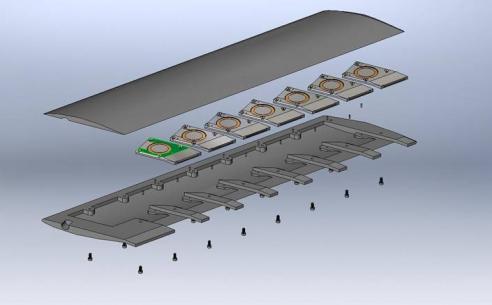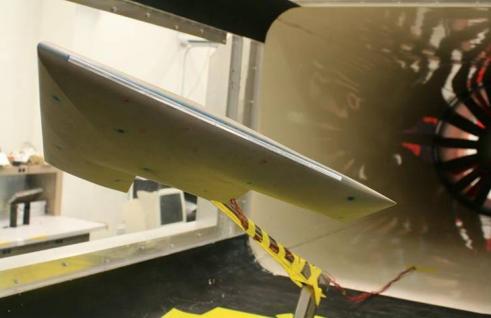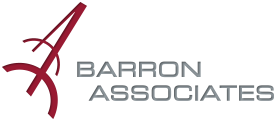Adaptive Control of Synthetic Jet Actuators
Traditionally, optimum aerodynamic performance and control on an airplane wing are achieved with good aerodynamic design of the wing section and the use of deflecting control surfaces. There are, however, limits on the angles of attack of wings and deflection angles of flaps beyond which separated flow over the surface degrades the performance. At these extremes when additional performance enhancements are demanded from the wings and the flaps, active flow control can be used to maintain attached flow and push the limiting angles to yet higher values. This active control capability suggests exciting possibilities for developing unique and extreme aircraft control approaches. Moreover, possibilities for virtual shaping of airfoils at low angles of attack suggest future aircraft that can maneuver without mechanical control surfaces. In addition, when used in aircraft design and retrofit, active flow control could lead to lighter, smaller, and less complex aircraft by reducing the size and part counts in the wing. Lighter aircraft with higher lift coefficients will also enjoy slower and safer takeoff and landing speeds.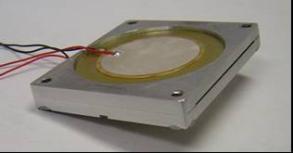
Active flow control using synthetic jet actuators has been the subject of significant research in recent years due to its immense potential to expand the operating regimes of unconventional airfoils, provide virtual shaping of airfoils and jet engine intakes, and control projectiles. Active flow control approaches can deliver variable power and may enable significant control authority. Synthetic jet actuators are zero net mass-flux devices that use a vibrating diaphragm to produce an oscillating flow through a small opening. Although there is no fluid source, a mean jet flow is established at the orifice. Synthetic jets are compact, lightweight, low-power devices that offer substantial control authority by displacing local flow streamlines.
Adaptive Control via the Adaptive Inverse Technique An obstacle to the widespread application of synthetic jet actuators for practical flight control is that modulated input signals to achieve closed-loop flow control objectives have been shown to be complex. The input signal variables that can be manipulated for control include the number of active jets in the array, and the signal amplitude, waveform, and frequency delivered to each jet. The control effect from manipulating each of these variables is often a highly nonlinear function. Developing a comprehensive, wind tunnel-validated model of synthetic jet actuators in a single application is technically challenging and expensive. Barron Associates, along with its research partners at the University of Virginia (UVA), have developed an adaptive control technique for arrays of synthetic jet actuators. This control technique, based on the adaptive inverse methodology, overcomes prior limitations and sets the stage for practical flight control applications using synthetic jet actuators. Importantly, the technique is widely applicable to many types of morphing (i.e., shape-changing) actuators and other active flow control actuators.
As shown below, the key features of the adaptive inverse approach are the adaptive compensator for the unknown actuator nonlinearity and the feedback adaptation for updating the compensator parameters. The essence of this adaptive approach is that, upon an adaptation transient, the compensator cancels the effects of the unknown nonlinear actuator characteristic so that a significant improvement of accuracy and performance is achieved. In other words, the adaptation of the controller is able to remove the unknown component nonlinearity so that a desired behavior of the system is realized. Note that the adaptive inverse compensator is integrated with the existing nominal guidance and control system. The nominal flight control system can be designed using any adaptive or non-adaptive feedback technique without considering the actuator nonlinearity. Importantly, adaptive inverse control laws are computationally efficient and readily implementable in low-cost computing hardware.
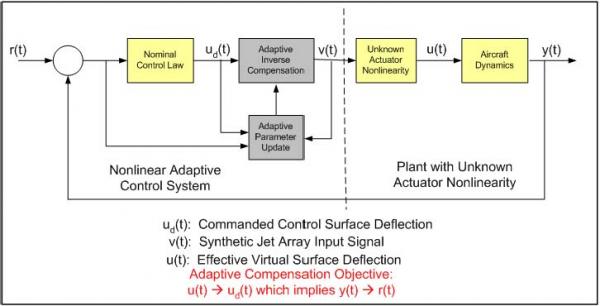
Recent Applications and Customers
Barron Associates, with its research partners at the University of Wyoming and the University of Virginia, has conducted extensive research in the areas of synthetic jet actuator design and layout as well as adaptive control. Customers include the U.S. Air Force Office of Scientific Research (AFOSR) and NASA Dryden Flight Research Center. Many potential applications exist for synthetic jet actuators and other active flow control techniques. Barron Associates will continue to develop and apply innovative adaptive control algorithms for a wide variety of actuators having complex, nonlinear dynamics.
